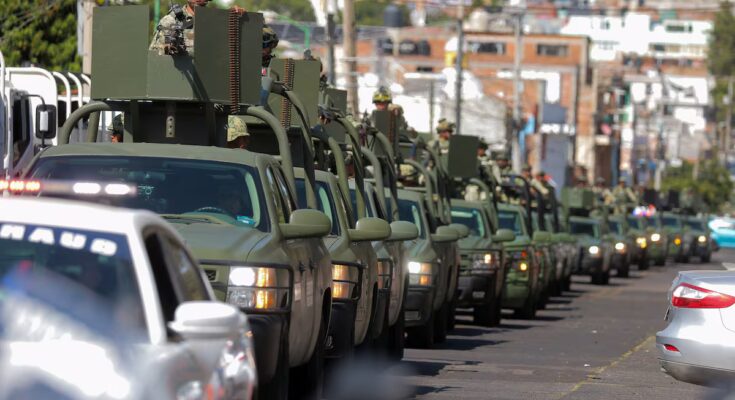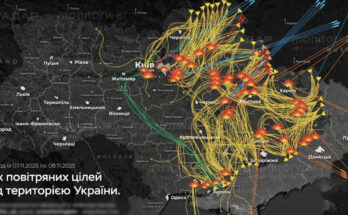Michoacán succeeds Sinaloa at the top of the federal government’s list of security concerns. The strategy for the state that Claudia Sheinbaum’s Executive presented this Sunday marks a change in its plans, an imposition of the situation of violence that the region suffers, a cyclical situation that none of the last four national administrations has been able to resolve. Sheinbaum’s plan involves investing 57 billion pesos, just over $3 billion, to tackle the problem at its root. The question now is whether the plan, which also proposes sending up to 10,000 soldiers while generating economic development, will take effect if the leap from paper to street meets the president’s intentions.
There has been no respite for Michoacán in recent weeks, marked by the murders of the popular mayor of Uruapan, the independent Carlos Manzo, and the leader of the Apatzingán Valley lemon producers, Bernardo Bravo. The attacks highlight a degradation of public security in the state, plagued by the activity of very violent criminal groups, such as Los Viagra and the Jalisco New Generation cartel. Extortion is common in the area, home to a strong agribusiness sector. The problem transcends the classic image of criminals coming to demand quotas from farmers. Criminal schemes are sophisticated and rooted in the legal economy.
Sheinbaum’s plan proposes 12 axes of action, which revolve around the government’s idea that violence is fought with force, but also by creating opportunities for the population. Planned actions range from strengthening security, building roads, developing economic centers and expanding government welfare programs. But beyond the deployment of additional soldiers to the area and the apparent landing of new investigative teams from the Federal Security Secretariat, the future seems uncertain. PRI state deputy Guillermo Valencia, who has been the party’s leader in the region, and mayor of Tepalcatepec, one of the area’s most complicated cities, near Apatzingán, says the plan is just a cover. “I don’t like it at all,” he says.
A friend of Manzo, Valencia has been highly critical of recent federal administrations and their approach to Michoacán. It was precisely during the years of the PRI Enrique Peña Nieto (2012-2018), when the self-defense movement was born in Apatzingán and surrounding areas, that the population fed up with the extortionists of the moment, in particular the criminal group of the Knights Templar. The plan then was to institutionalize the self-defense groups, with government support, an idea that ended up with hundreds of weapons in their hands and a good portion of their members integrated, over time, into the ranks of new criminal groups. “With this new plan, everything is missing,” protests the politician. “Everything we take on as support or provision, for example schools and hospitals, was already in the spending budget,” he adds.
Salvador Maldonado, an expert on insecurity and violence at the Colegio de Michoacán, is also critical. He agrees with Valencia that the changes in the budget are minimal. “What is proposed is to reorient and concentrate what is already budgeted,” he says. He is “impressed” by the military deployment in the region, which will reach 10,506 elements. And he underlines a question: “The question that remains is whether this plan to militarize Michoacan society is really a way to dismantle criminal activities. Because there have been the same initiatives in the past.” The results, evidently, were not the best.
Lawyer Ignacio Mendoza is more cautious. Mendoza was part of the state government led by moraineist Alfredo Ramírez Bedolla. He was head of the region’s prisons until he resigned last year, forced by accusations of torture which, as he explains, led to nothing. Veteran of local politics, deputy prosecutor for more than 15 years, local official of the capital Morelia, Mendoza claims that the current plan contains “different ingredients” compared to previous plans and that, even if the State “may seem askew”, the “cooks” that Sheinbaum has appointed responsible for public security at the federal level are a guarantee, referring to Omar García Harfuch and his team.
The lawyer recalls that, starting from Vicente Fox’s six-year term (2000-2006), all governments have developed some sort of plan for Michoacán. “In those years, in 2005, the (criminal groups) from the Pacific were fighting here with those from the Gulf. So Fox sent a lot of Federal Police, but they were questioned a lot because they arrived in a crazy way, without a strategy, which increased the violence. In that context, it was when they killed Rogelio Zarazúa,” he explains. Director of the State Police, the criminals killed Zarazúa in Morelia in September 2005. “They went as far as blindfolded and, obviously, they hit the hornet’s nest.”
The next plan was that of Felipe Calderón (2006-2012), a Michoacan like Mendoza, who had just settled in the residence of Los Pinos, when he launched “Operation Cleanliness”, a program against the collusion of crime with state and local authorities, which had its replica in the State, with the famous michoacanazo. In May 2009, the attorney general’s office arrested 31 people, including mayors and local and state officials, for organized crime, among other crimes. Then deputy attorney general in Morelia, Mendoza was among them. Despite the spectacular nature of the operation, the PGR was unable to prove a single accusation. In time they were all freed.
Mendoza remembers the michoacanazo because, according to him, this and other similar operations, in Hidalgo or Zacatecas, “have managed to convince local authorities to take their hands off fighting crime in the local jurisdiction”. Mendoza continues and adds that “that was the turning point in violence in this country. And we couldn’t get state and local authorities to take up the role of prosecuting local crimes, of which more than 90 percent are committed.” Several experts have underlined in recent days the need to strengthen local and state police, as well as the authorities on which they depend. It is the guarantee, they point out, that federal intervention will be successful in the long term.
Salvador Maldonado, of the Colegio de Michoacán, expresses doubts about this. “This plan can lead to the same previous experience: there’s a fire, they come to put it out and they leave, which is what happened cyclically,” he says. “There is no evidence that allows us to see how these strategies will be implemented and whether they will be successful in the medium, long or term. Or whether, on the contrary, it is a temporary fire extinguisher. The plan has objectives, but not the hows, which are always the big gaps in these plans. It is difficult to know how they will propose it, especially taking into account this logic of containment that it emanates,” he concludes.



